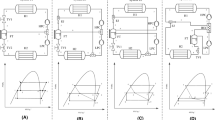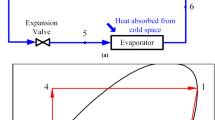Abstract
In this paper, an ejector enhanced high-temperature heat pump with dual-pressure condensation and evaporation is proposed to improve the system performance. Theoretical analyses of the system operation characteristics are conducted using energetic and exergetic methods. The performance comparisons among the basic cycle, parallel compression cycle, and ejector enhanced cycle are conducted with six different refrigerants, including R245fa, R600a, R1234ze(Z), R1336mzz(Z), R1224yd(Z), and R1233zd(E). The results demonstrate that environmentally-friendly refrigerant R1234ze(Z) would be a promising alternative refrigerant. Compared with the basic cycle and parallel compression cycle at selected operation conditions, 29.5% and 12.6% improvements in COP, and 16.7% and 11.1% higher system exergy efficiency are achieved in the ejector enhanced cycle on average. The volumetric heating capacity of the ejector enhanced cycle is increased by 15.7%–21.7%. The ejector enhanced cycle outperforms the other two cycles in high-temperature heat pump applications at the large temperature lift and temperature rise in the heat sink. The assessment offers an option to improve the energy utilization efficiency of the high-temperature heat pumps.
Similar content being viewed by others
Abbreviations
- COP:
-
coefficient of performance
- Ė :
-
exergy flow rate/kW
- e :
-
specific exergy/kJ·kg−1
- h :
-
specific enthalpy/kJ·kg−1
- m :
-
mass flow rate/kg·s−1
- P :
-
pressure/MPa
- Q h :
-
heat load/kW
- q v :
-
volumetric heating capacity/kJ·m−3
- r P :
-
pressure lift ratio of an ejector
- s :
-
specific entropy/kJ·kg−1·K−1
- T :
-
temperature/°C
- v :
-
specific volume/m3·kg−1
- VR :
-
compressor displacement ratio
- W :
-
power/kW
- ε k :
-
exergy efficiency of system component
- η :
-
efficiency
- μ :
-
entrainment ratio
- ξ k :
-
exergy destruction ratio of system component
- com:
-
compressor
- con:
-
condenser
- D:
-
exergy destruction
- d:
-
diffuser
- eje:
-
ejector
- ev:
-
evaporator
- exp:
-
expansion valve
- F:
-
exergy fuel
- HP:
-
high-pressure evaporation/condensation
- i:
-
inlet
- ihx:
-
internal heat exchanger
- is:
-
isentropic process
- lift:
-
Temperature lift
- LP:
-
low-pressure evaporation/condensation
- n:
-
nozzle
- o:
-
outlet
- P:
-
exergy production
- p:
-
primary flow
- s:
-
secondary flow
- sink:
-
heat sink
- source:
-
heat source
- sub:
-
subcooling state
- sup:
-
superheating state
- sys:
-
system
- tot:
-
total
- 0:
-
reference condition
- 1–15:
-
state point
References
IEA, World energy balances: overview 2018. 2018.
Miernicki E.A., Heald A.L., Huff K.D., Brooks C.S., Margenot A.J., Nuclear waste heat use in agriculture: History and opportunities in the United States. Journal of Cleaner Production, 2020, 267: 121918.
Arpagaus C., Bless F., Uhlmann M., Schiffmann J., Bertsch S.S., High temperature heat pumps: Market overview, state of the art, research status, refrigerants, and application potentials. Energy, 2018, 152: 985–1010.
Juhasz J.R., Novel working fluid, HFO-1336mzz(E), for use in waste heat recovery application. 12th IEA Heat Pump Conference, Rotterdam, Netherlands, 2017.
Chen J., Jarall S., Havtun H., Palm B., A review on versatile ejector applications in refrigeration systems. Renewable and Sustainable Energy Reviews, 2015, 49: 67–90.
Xu Y., Wang C., Jiang N., Song M., Wang Q., Chen G., A solar-heat-driven ejector-assisted combined compression cooling system for multistory building — Application potential and effects of floor numbers. Energy Conversion and Management, 2019, 195: 86–98.
Xu Y., Jiang N., Han X., Han W., Mao N., Chen G., Performance evaluation and energy-saving potential comparison of a heat-powered novel compression-enhanced ejector refrigeration cycle with an economizer. Applied Thermal Engineering, 2018, 130: 1568–1579.
Hao X., Wang L., Wang Z., Tan Y., Yan X., Hybrid auto-cascade refrigeration system coupled with a heat-driven ejector cooling cycle. Energy, 2018, 161: 988–998.
Wang X., Yan Y., Wright E., Hao X., Gao N., Prospect evaluation of low-GWP refrigerants R1233zd(E) and R1336mzz(Z) used in solar-driven ejector-vapor compression hybrid refrigeration system. Journal of Thermal Science, 2020, 30: 1572–1580.
Bai T., Lu Y., Yan G., Yu J., Performance analysis of an ejector enhanced two-stage auto-cascade refrigeration cycle for low temperature freezer. Journal of Thermal Science, 2020, 30: 2015–2026.
Li Y., Yu J., Thermodynamic analysis of a modified ejector-expansion refrigeration cycle with hot vapor bypass. Journal of Thermal Science, 2019, 28: 695–704.
Jeon Y., Kim D., Jung J., Jang D.S., Kim Y., Comparative performance evaluation of conventional and condenser outlet split ejector-based domestic refrigerator-freezers using R600a. Energy, 2018, 161: 1085–1095.
Luo B., Zou P., Performance analysis of different single stage advanced vapor compression cycles and refrigerants for high temperature heat pumps. International Journal of Refrigeration, 2019, 104: 246–258.
Guo H., Gong M., Qin X., Performance analysis of a modified subcritical zeotropic mixture recuperative high-temperature heat pump. Applied Energy, 2019, 237: 338–352.
Nguyen A., Eslami-Nejad P., A transient coupled model of a variable speed transcritical CO2 direct expansion ground source heat pump for space heating and cooling. Renewable Energy, 2019, 140: 1012–1021.
Hu B., Xu S., Wang R.Z., Liu H., Han L., Zhang Z., Li H., Investigation on advanced heat pump systems with improved energy efficiency. Energy Conversion and Management, 2019, 192: 161–170.
Zhao Z., Tian Y., Hou F., **ng Z., Performance analysis of a refrigerant extracting twin screw compressor employed in multi-temperature heat pump systems. International Journal of Refrigeration, 2016, 67: 383–394.
Wang K., Cao F., Wang S., **ng Z., Investigation of the performance of a high-temperature heat pump using parallel cycles with serial heating on the water side. International Journal of Refrigeration, 2010, 33: 1142–1151.
Zhang Z., Feng X., Tian D., Yang J., Chang L., Progress in ejector-expansion vapor compression refrigeration and heat pump systems. Energy Conversion and Management, 2020, 207: 112529.
Chesi A., Esposito F., Ferrara G., Ferrari L., Experimental analysis of R744 parallel compression cycle. Applied Energy, 2014, 135: 274–285.
Pardiñas Á.Á., Hafner A., Banasiak K., Novel integrated CO2 vapour compression racks for supermarkets. Thermodynamic analysis of possible system configurations and influence of operational conditions. Applied Thermal Engineering, 2018, 131: 1008–1025.
Schulz M., Kourkoulas D., Regulation (EU) No 517/2014 of The European Parliament and of the council of 16 April 2014 on fluorinated greenhouse gases and repealing Regulation (EC) No 842/2006. Official Journal of the European Union, 2014: L150.
Flerlage H.F., Velders G.J.M., Boer J., A review of bottom-up and top-down emission estimates of hydrofluorocarbons (HFCs) in different parts of the world. Chemosphere, 2021, 283:131208.
Bai T., Yan G., Yu J., Thermodynamic assessment of a condenser outlet split ejector-based high temperature heat pump cycle using various low GWP refrigerants. Energy, 2019, 179: 850–862.
Fukuda S., Kondou C., Takata N., Koyama S., Low GWP refrigerants R1234ze(E) and R1234ze(Z) for high temperature heat pumps. International Journal of Refrigeration, 2014, 40: 161–173.
Malavika S., Chiranjeevi C., Raja Sekhar Y., et al., Performance optimization of a heat pump for high temperature application. MaterialstToday: Proceedings, 2021, 46: 5278–5285.
Mateu-Royo C., Sawalha S., Mota-Babiloni A., Navarro-Esbrí J., High temperature heat pump integration into district heating network. Energy Conversion and Management, 2020, 210: 112719.
Mota-Babiloni A., Navarro-Esbrí J., Molés F., Cervera Á.B., Peris B., Verdú G., A review of refrigerant R1234ze(E) recent investigations. Applied Thermal Engineering, 2016, 95: 211–222.
Bamigbetan O., Eikevik T.M., Nekså P., Bantle M., Schlemminger C., Theoretical analysis of suitable fluids for high temperature heat pumps up to 125°C heat delivery. International Journal of Refrigeration, 2018, 92: 185–195.
Bamigbetan O., Eikevik T.M., Nekså P., Bantle M., Review of vapour compression heat pumps for high temperature heating using natural working fluids. International Journal of Refrigeration, 2017, 80: 197–211.
Kondou C., Koyama S., Thermodynamic assessment of high-temperature heat pumps using Low-GWP HFO refrigerants for heat recovery. International Journal of Refrigeration, 2015, 53: 126–141.
Frate G.F., Ferrari L., Desideri U., Analysis of suitability ranges of high temperature heat pump working fluids. Applied Thermal Engineering, 2019, 150: 628–640.
Lemmon E.W., Huber M.L., Mclinden M.O., NIST Standard ReferenceDatabase 23: Reference Fluid Thermodynamic and Transport Properties-REFPROP. 10.0, NIST NSRDS, 2018.
He S., Li Y., Wang R.Z., Progress of mathematical modeling on ejectors. Renewable and Sustainable Energy Reviews, 2009, 13: 1760–1780.
Liu F., Groll E.A., Study of ejector efficiencies in refrigeration cycles. Applied Thermal Engineering, 2013, 52: 360–370.
Zhou M., Wang X., Yu J., Theoretical study on a novel dual-nozzle ejector enhanced refrigeration cycle for household refrigerator-freezers. Energy Conversion and Management, 2013, 73: 278–284.
Sarkar J., Performance analyses of novel two-phase ejector enhanced multi-evaporator refrigeration systems. Applied Thermal Engineering, 2017, 110: 1635–1642.
Helvaci H.U., Khan Z.A., Thermodynamic modelling and analysis of a solar organic Rankine cycle employing thermofluids. Energy Conversion and Management, 2017, 138: 493–510.
Wu W., You T., Wang J., Wang B., Shi W., Li X., A novel internally hybrid absorption-compression heat pump for performance improvement. Energy Conversion and Management, 2018, 168: 237–251.
Bai T., Yu J., Yan G., Advanced exergy analyses of an ejector expansion transcritical CO2 refrigeration system. Energy Conversion and Management, 2016, 126: 850–861.
Wang X., Yu J., An investigation on the component efficiencies of a small two-phase ejector. International Journal of Refrigeration, 2016, 71: 26–38.
Acknowledgments
This study is financially supported by the National Natural Science Foundation of China (NSFC) under grant No. 51806160 and the China Postdoctoral Science Foundation (CPSF) under grant No. 2018M640982.
Author information
Authors and Affiliations
Corresponding author
Rights and permissions
About this article
Cite this article
Bai, T., Liu, Y., Yan, G. et al. Theoretical Performance Analysis of an Ejector Enhanced High-Temperature Heat Pump with Dual-Pressure Condensation and Evaporation. J. Therm. Sci. 31, 1367–1379 (2022). https://doi.org/10.1007/s11630-022-1588-7
Received:
Published:
Issue Date:
DOI: https://doi.org/10.1007/s11630-022-1588-7




